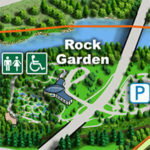| Membership | Price (+HST) |
|---|---|
| Single | $85/year |
| Single Plus | $120/year |
| Family | $130/year |
| Family Plus | $175/year |
| Contributing | $300/year |
| Supporting | $600/year |
| Sustaining | $1,000/year |
| Benefactor's Circle | $2,500/year |
| Director's Circle | $5,000/year |
| President's Circle | $10,000/year |
Curation of Living Collections
Curating RBG’s Living Collections
RBG maintains and develops over 40 living plant collections spread throughout the Arboretum, Rock Garden, Laking Garden, Hendrie Park and RBG Centre. Of particular note are iris, rose, lily and lilac collections, the latter of which is one of the world’s largest and most diverse lilac collections and a global reference point for this genus. Collections may be displayed on their own, for example the Lilac Collection, or integrated with other plants, for example the Lily Collection. Some collections such as the Japanese Flowering Cherries may form a multi-site collection held both in more than one garden area (the Arboretum and Rock Garden).
What is a Living Collection?
RBG defines a Living Collection as a group of plants grown, assembled and displayed for a predetermined purpose. The horticulture team accessions and assembles plants according to the following categories:
- Taxonomic (by plant genus) e.g. Lilac Collection
- Geographic (by geographical location or range) e.g. Mediterranean Garden
- Horticultural (with horticultural significance) e.g. Magnolia Collection
- Morphological (by form, traits or plant characters) e.g. Weeping Tree Collection
- Display (with an aesthetic function) e.g. Scented Garden
- Economic (plants with ethnobotanical interest) e.g. Medicinal Garden
- Conservation (rare or endangered species both wild and cultivated) e.g. rare plants within RBG’s Living Collections
- Other (for example, heritage plants) e.g. Barbara Laking Heritage Garden
The Lilac Collection, for example, is categorized as a taxonomic, horticultural and display collection.
Purpose of the Living Collections
RBG’s Living Collections support our core mandates of science, horticulture, education and conservation. As with a museum, the Living Collections dedicate RBG to improving the understanding and knowledge of all plants held within the collections. By accumulating, generating and disseminating this knowledge, RBG promotes humanity’s understanding of the relationship between the plant world, society and environment, and create awareness that all life is dependent upon plants.
Protect and Respect our Collections
Royal Botanical Gardens is a mixture of gardens and nature sanctuaries intended for the study and appreciation of plants, animals and the natural world. Group or individual activities should not have a detrimental impact on our collections or landscapes. Our collections are unique and precious.
Anyone using the gardens should not:
- Damage or remove plant material
- Climb trees
- Walk in planted beds or cultivated areas
- Dogs must be on a leash at all times and owners responsible for removal of their animals waste.
- Fires and Barbecues are prohibited
- Organized group sports are prohibited
- Bicycles are prohibited
Curator of Living Collections
The role of the Curator of Living Collections within a botanical garden is often diverse and may vary from garden to garden. Here at RBG it can be defined as being involved with the following areas of work:
- Governing collections – to guide and limit what is collected normally through the creation or revision of curatorial guiding documents such as a Living Collections Policy and a Living Collections Management Plan. These policies and plans ensure RBG’s collections have meaning and are current with RBG’s mandate mission and vision.
- Developing Collections – collections evolve over time so it is essential to acquire new plants to ensure the collections are current, meaningful and have value for the future. Plants may be acquired through field collection, exchange via other gardens, purchase or donation.
- Plant Documentation – without minimum standards of documentation a collection (or plants within a collection) have little value, relevance and tell no story. The information added to the RBG plant records ensures the collections are distinguished from a random assemblage of plants with no meaning to collections with high horticultural, scientific, conservational, educational and cultural value.
- Preserving Collections – making sure that adequate management plant care and horticultural practices are in place with emphasis on preserving and protecting the collections for future generations.
- Research – the search to discover new plant knowledge and to record, interpret and disseminate this information.
- Interpretation and Programming – to support collections based interpretation, programming and outreach and in order to make the collections accessible physically and intellectually.
Plant Identification
RBG curates the Living Collections to make sure that plants are correctly identified, current taxonomic and classification schemes are applied and that correct nomenclature is being used. This is accomplished by:
- Preparing voucher specimens and adding to the RBG Herbarium (HAM).
- Receiving herbarium specimens of nomenclatural standards for registered cultivars.
- Weekly meetings of RBG’s Taxonomic Working Group to resolve nomenclature and taxonomy challenges.
- Networking with horticulturists, scientists, taxonomists, botanists and scholars with expertise in a particular plant family or genus.
- Dealing directly with plant breeders at a cultivar level whenever possible.
- Working closely with flower societies with expertise within a particular genus.
- Reviewing current up to date curatorial references and botanical literature
Support Horticulture at RBG
The care and growth of our horticultural collections are possible thanks to the generous support of RBG Members and donors. With a donation to Growing up Green, you can ensure an active, vibrant and healthy future for the children of today and tomorrow through our horticultural and conservation projects.
Royal Botanical Gardens (RBG) is the largest botanical garden in Canada, a National Historic Site, and registered charitable organization with a mandate to bring together people, plants and nature.
Living Collections Policies
At RBG the basic function of the Living Collections Policy is to guide the development, management and enhancement of the Living Collections. The policies are written and administered by the Curator of Collections in consultation with RBG’s Curatorial Team consisting of The Head of Horticulture, The Head of Science, The Herbarium Curator and Head of Education. It is further approved by the Chief Executive Officer and Board of Directors. The Policy is reviewed by the Curatorial Team every five years and acts as a management tool to inform:
- What plants should be collected.
- How the collection is developed in the short, medium and long term.
- Who is responsible for managing and maintaining the collection?
- How accessions are verified, identified and correctly named
- How the plants are documented, labeled and mapped
- Identify those plants no longer relevant in supporting RBG’s mandate, mission and vision
Minimum Standards for Curatorial Procedures
Minimum standards require that the following information be recorded for all plants in the collections:
- Accession number.
- Date of acquisition.
- Date of accession.
- Scientific name (family, genus, species, author, intraspecific rank, hybrid, cultivar).
- Number received.
- Form of plant (e.g. plant, cutting, seed, division).
- Source (e.g. garden, nursery, plant breeder, institution).
- How received (e.g. exchange, purchase donation).
- Provenance (e.g. wild or cultivated, locality, country).
- Present location within garden.
- Date planted.
- Condition and status of plant (alive, dead, deaccessioned).
The curation and curatorial practices linked to the Living Collections is one of museological functions that sets a botanical garden apart form a public garden, park, or general amenity green space.
Ethical Collecting
RBG pledges to comply with all international, federal, and provincial legislation and/or treaties regarding the collection of living plant material and will not knowingly acquire plants that are in violation of such measures. RBG will not acquire plants for the collections that are known to be invasive in natural areas of southern Ontario or otherwise threaten the health and safety of plants classified as being species at risk. If collection of wild plants is to occur, it will be conducted in accordance with the most current best practices for sustainable harvest.

















